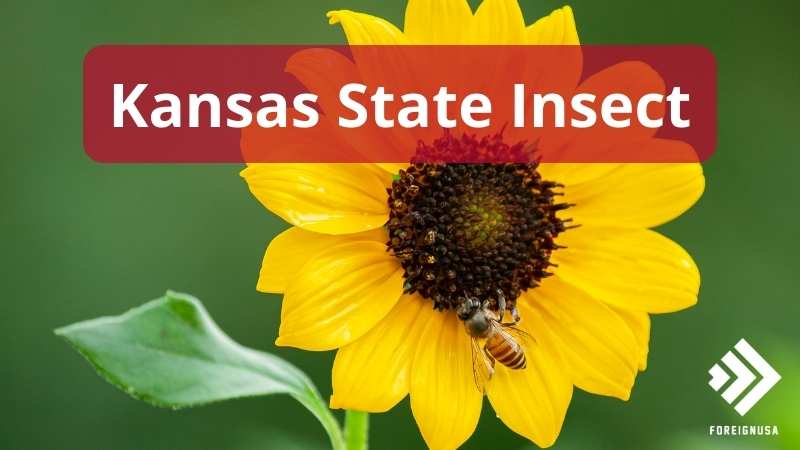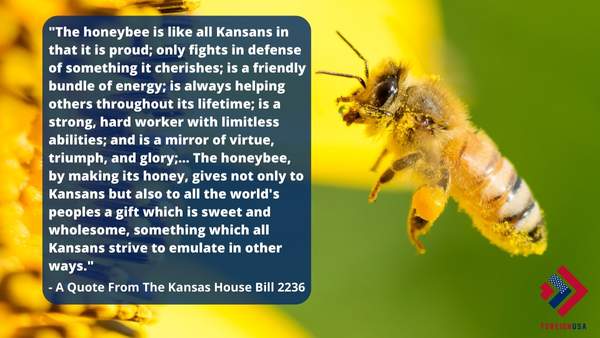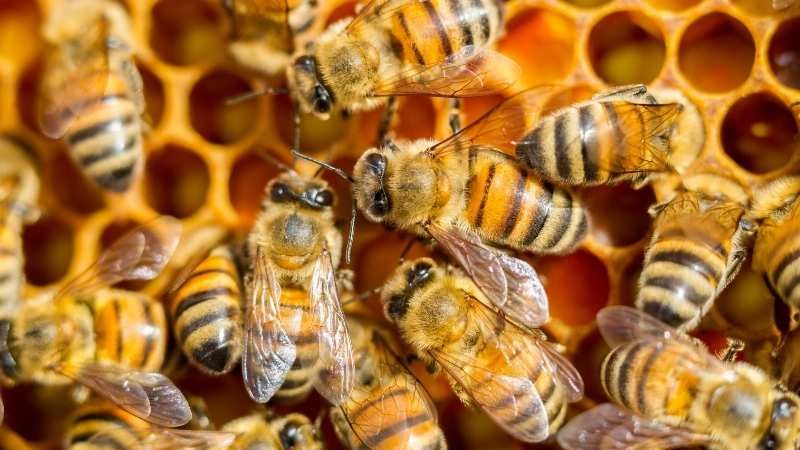The state of Kansas first began adopting its own state symbols in 1861 when the great state seal was created and adopted. Since then, many more have been acquired. A state symbol typically comes in the form of state animals, mammals, birds, flowers, butterflies, fruits, vegetables, amphibians, trees, nicknames, and many more.

Kansas state symbols were adopted by the state through the people and governing bodies to best represent the state and its historical roots, incredibly unique wildlife and nature, and geological features of Kansas. Like all other states, Kansas state symbols represent the state and all of its past and present endeavors.
What is the State Insect of Kansas?
The state insect of Kansas is the honeybee (Apis) and has been since its original adoption back in 1976. Kansas adopted the honeybee as the 9th official symbol of the state, this was in response to a petition signed by more than two-thousand Kansas schoolchildren who wished for the famous honeybee to represent their state.
A famous quote that came with the adoption of this famous Kansas symbol reads as follows; “The honeybee is like all Kansans in that it is proud; only fights in defense of something it cherishes; is a friendly bundle of energy; is always helping others throughout its lifetime; is a strong, hard worker with limitless abilities; and is a mirror of virtue, triumph, and glory;…
The honeybee, by making its honey, gives not only to Kansans but also to all the world’s peoples a gift which is sweet and wholesome, something which all Kansans strive to emulate in other ways.” – from Kansas House Bill 2236.

This quote certainly did resonate with many people from the state, which in return created much unity in the adoption of the honeybee as the official insect to represent Kansas. Bee pollination is imperative in the survival of humans and plants, and it isn’t just honey that bees create either.
Plants and flowers use up a lot of energy when they attempt to attract bees and other insects to pollinate them. Typically, they will display bright colors and produce sweet nectar. A flower that relies heavily on pollination is the Kansas state flower. Bee pollination is one of the most important aspects of producing sunflower seeds.
Unsurprisingly, the honeybee is used to represent twenty states, including Kansas. This is due to honeybees playing such a pivotal role in our ecosystem.
Additional Information and History of Honeybees
Honeybees are social beings, typically residing in hives that consist of over 80,000 individuals. Hives usually have one queen bee, who is the dominant and largest of the residents, who can lay over 1,500 eggs per day and will live for 8 or more years!
Within the hive, there are usually a small group of male “drones” who are used to fertilize a new queen, and the others are mostly sterile female worker bees.
There are younger worker bees too, which are called “house bees”, who will use their incredible intuition to construct the hive and also maintain the honeycomb. House bees also care for eggs and larvae and also defend the hive with all they’ve got.
The older workers are called “field bees,” and they are the explorers who will go and gather nectar, pollen, water, and plant resins which are used as materials to create the hive. These worker bees have an extra stomach with special pollen baskets on their hind legs too, for more room to transport resources.

Some evidence suggests that honeybees have developed their own dance to alert one another of the location of nectar and pollen. Unlike their queens, worker bees will typically only live for 6 weeks during the summer months. However, the honeybees that are hatched in the fall will survive until the following spring.
Incredibly, the existence of bees dates back over 40 million years ago, and the honeybee has remained physically and socially unchanged for more than 30 million years.
The most likely scenario is that honeybees originated from tropical Africa, and they were brought to the “New World” with the Spanish and British colonists. After being brought over, they quickly escaped into the wild and started to do their work in the western hemisphere. Many Native Americans used to call the honeybee “White Man’s Flies”.
Conclusion
Most states will have their symbols showcase a relevant story, that is indicative of the state and its history, and the Sunflower State puts its history and what it stands for across very well in the Kansas state insect. This interesting fact about Kansas and a whole host of others are what makes the state so unique and fascinating to those that live there or are researching the historical events of the state.


